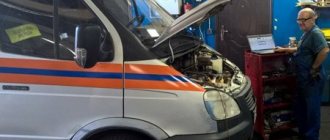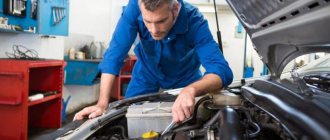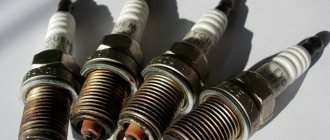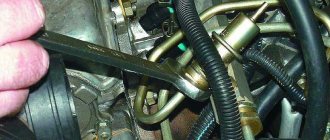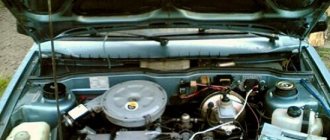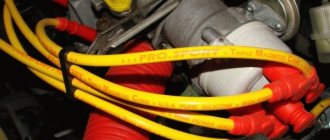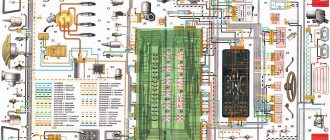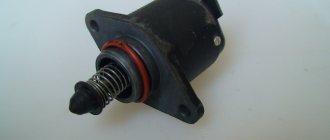Why does the VAZ 21099 carburetor twitch during acceleration?
If you encounter a problem such as the VAZ 2109 jerking while driving, then the reason may be hidden in a malfunction such as:
- Power system problem.
- Ignition system problem.
Also, one of the main reasons that the VAZ 2109 jerks when driving is the carburetor, which urgently needs to be checked.
To determine if a car is broken, you must first prepare two wrenches (one eight, the other ten), two screwdrivers (one Phillips, the other straight), as well as a clean rag and thin copper wire. You will also need a compressor and liquid.
Let's sum it up
So, we see that a car can jerk for many reasons. As a rule, it helps to alternately replace consumables (filters, spark plugs, armored wires) and clean the injector nozzles. It is better to entrust the check of electronics and sensors to a specialist at a service station.
Often the problem can also lie in the transmission; the car also “jumps” in this case - especially with an automatic transmission, although manual transmissions are also prone to failure. In a manual transmission, replace the basket and/or clutch disc.
The automatic transmission checks the oil for its level and quality. Please note that qualified repair of an automatic transmission “in a garage” is impossible; it must be diagnosed at a service station.
Your actions
- Remove the cover from the air filter.
- Remove the filter.
- Remove the drive vacuum corrector hose.
- Replacing the corrector (possible).
- Check the carburetor.
- Remove the hose that leads to the fuel.
- Pull the distributor out of the socket.
- Clean the nozzle hole.
- Put the sprayer back.
- Assemble the carburetor.
- Check the retraction of the drive lever.
- Check the trickles.
Next, most likely you will have to go to a service center or read how to properly adjust the carburetor here.
If the VAZ 2109 carburetor twitches during acceleration
It also happens that the carburetor of a VAZ 2109 twitches during acceleration. In this case, the list of reasons is quite large and it is not so easy to determine what kind of malfunction led to this behavior of your car.
- incorrect operation of the gasoline pump;
- problems in the fuel filter;
- clogging of the additional filter;
- there are ignition problems;
- very low fuel level in the tank.
And this is not a complete list. It will be quite difficult to find the reason on your own. If the carburetor twitches when accelerating a VAZ 2109, then it is better not to try to repair the car yourself. In this case, contact the service center and professionals who will be able to find and eliminate the cause of the problem. And it’s better not to delay contacting the salon for too long.
It also happens that the carburetor of a VAZ 2109 twitches during acceleration.
In this case, the list of reasons is quite large and it is not so easy to determine what kind of malfunction led to this behavior of your car.
VAZ 2106 | The car moves jerkily
In relation to a car, a jerk is a short-term spontaneous change in the engine crankshaft speed, regardless of the position of the gas pedal. In everyday use, as a rule, there are a series of jerks. The extreme case of a jerk is a failure, a noticeable delay in the engine's response to pressing the accelerator pedal.
Conventionally, three types of jerks can be distinguished:
- at the moment of starting movement;
– during acceleration;
– with steady motion, i.e. with the accelerator pedal in constant position.
To determine the causes of jerks when driving a car with an injection engine, special diagnostic equipment is required, so in this case we recommend contacting a car service center that specializes in repairing fuel injection systems. However, as practice shows, in most cases jerking is caused by insufficient fuel pressure in the engine fuel line (“rail”) or a malfunction of the throttle position sensor.
If you have some skills, you can identify the cause of jerking yourself.
Jerking when starting to move
At the moment the movement begins, the limiting case of a jerk often occurs - failure. The most unpleasant sensations are associated precisely with the delay in the engine’s response to pressing the gas pedal. Sometimes the engine even stalls. A jerk occurs at the moment the throttle valve begins to open, when, based on a signal from the throttle position sensor, the ECU determines the moment of transition from idle mode to load mode and must increase the amount of fuel supplied through the injectors. If the pressure in the fuel line is insufficient, even with increasing injection duration, there is not enough fuel for a smooth start.
| , cm2 to a special fitting on the fuel line using a piece of suitable hose . , the pressure in the fuel line must be at least 3 kgf/ cm2 . |
| NOTE The pressure test fitting has a design similar to a tire valve, with a spool. Therefore, you can use a foot tire pump hose connector to connect the pressure gauge hose. |
The reasons for the decrease in pressure may be:
| – faulty pressure regulator . In addition, failure of the regulator may be caused by a loose fitting of the hose on the fitting of the vacuum chamber of the regulator; |
| – clogged fuel filter; |
| – faulty fuel pump. |
| NOTE For methods of checking and replacing the pressure regulator, fuel filter and fuel pump, see section. 4 “Engine”, in subsection. "Supply system". |
Jerks during acceleration
The cause of jerking during acceleration may be, just as in the previous case (see “Jerking at the moment of starting movement”), insufficient fuel pressure in the fuel line. The ECU, having received a signal from the throttle position sensor about the intensive opening of the throttle at a large angle, strives to maximize the fuel supply, but due to the reduced fuel pressure it is not able to do this. For the reasons for this phenomenon and the method of checking, see “Jerk at the moment of movement starts.”
Jerks during steady motion
Such jerking is most often caused by a malfunction of the ignition system. Diagnostics and repair are necessary (see section 9 “Electrical equipment”). On the way, you can try to do it yourself:
– carefully inspect the engine compartment. Turn off the ignition and check the secure fastening and seating of all wires and connectors at the ignition module and high-voltage wires. Start the engine and listen to its operation - the crackling sound when the high voltage breaks down to ground is weak, but distinct. In complete darkness, the spark during breakdown is clearly visible;
– replace spark plugs regardless of their condition and mileage
Pay attention to the condition of the spark plugs - if they are abnormal, the engine or its systems may need to be repaired
| A specific cause of jerking during steady motion of a car with an injection engine may be damage to the throttle position sensor. Additional symptoms confirming the malfunction of this sensor are: – uneven operation of the engine at idle; – reduction in maximum engine power. |
The sensor is not dismountable and therefore cannot be repaired. If a sensor malfunction is detected (see section 9 “Electrical equipment”, “Engine control system”), it is replaced as an assembly.
automn.ru
Causes of malfunction
Troubleshooting is an incorrect air-fuel mixture ratio in the combustion chamber or a lack of spark. In this case, the crankshaft may turn with difficulty, or there will be misfires.
Many car enthusiasts started with carburetor engines and therefore know perfectly well why the engine misfires, but not everyone can fix the problem because they don’t know what the problem is. It is worth understanding that the tripping effect occurs due to a disruption in the supply of one of the elements - air, fuel and spark. It is in the systems that are responsible for these elements that we should look for the cause.
So, let's look at the components where you should look for the reason why the VAZ 2109 engine with a carburetor injection system is tripping:
- Carburetor.
- Fuel.
- Fuel pump and filter.
- Spark.
- Air filter.
Malfunctions of the VAZ 2108, 2109, 21099 generator
The generator is responsible for power supply to the entire on-board network of a car with a running engine.
Its malfunction leads either to a cessation of electric current production (charging) or to an excessive increase in voltage (battery overcharging). On VAZ 2108, 2109, 21099 cars, the easiest way to identify the causes of a generator malfunction is by external signs.
Signs of a malfunction of the generator of VAZ 2108, 2109, 21099 cars
After starting the engine, the battery discharge indicator lamp in the instrument panel lights up
The generator does not produce the required charging current. Simultaneously with the light on, the voltmeter readings tend to zero. The battery is constantly not recharged. Using a voltmeter (multimeter), we check the voltage at the battery terminals (the engine is idling). The voltmeter readings should be as follows: generator 37.3701 - 13.6 V, generator 9402.3701 - 13.2 V.
The “folk” method of checking a generator by removing the terminal from the battery while the engine is running is only suitable for carburetor engines. If the engine stalls after removing the terminal, it means the generator has stopped producing electric current.
If it is less, then the problem is not in the faulty wiring going to the control lamp and voltmeter, but in the generator. Next, sequentially, from simple to complex, from the most probable to the least probable, we look for the cause of the malfunction.
Take care of those you have tamed
But never set foot on a compromised gas station! Use only proven network gas stations. You have an “old” car, it needs to be cared for and cherished, given regular oil from certified manufacturers on time, filled with high-quality gasoline and loved.
It is not hard. There are quite a lot of reputable companies in the country that have long and tightly occupied their market niches, care about their reputation, and have certified quality assurance systems. Among them are representatives of the world's largest oil companies. They carry out geological exploration, development, and exploitation of oil fields, production and marketing of petroleum products. The gas stations of these companies offer all types of motor fuel.
A typical gas station is usually a large complex with 12 or more gas stations. The driver can get the necessary assistance from a gas station attendant, pump up the tires of his car, top up the radiator with water, use the toilet at no extra charge, and shop at a self-service mini-market where snacks and drinks, including chilled ones, are available. Gas stations have a small cafe; the gas station often smells of freshly brewed coffee.
Don’t be fooled by the cheapness, fill in with high-quality fuel and go ahead.
A situation where a car starts to jerk for no reason can occur to every car owner several times a year. In most cases, the problem can be resolved quickly. At the same time, you need to understand that the maximum wear of some machine components can lead to a major overhaul of the affected systems. If the car stalls while driving and jerks with a loss of speed, then it’s time to take action.
How can I find out the circumstances of the malfunction?
- You will need two wrenches - “ten” and “eight”, a Phillips screwdriver and a straight, clean rag, a little bronze wire. The wire diameter should be already 0.3 mm.
- In addition, liquid and a WD40 compressor will be useful.
The operating procedure is as follows:
- Armed with a ten key, remove the cover from the air filter housing by unfastening the spring fasteners. Remove the filter. Using an eight-mm wrench, unscrew the nuts and now you can loosen the clamp on the crankcase ventilation hose where it connects to the valve cover. It is then possible to remove the filter housing.
- Now you need to remove the vacuum corrector drive hose and create a vacuum to make sure it is tight.
- Perhaps the corrector will need to be replaced. It’s better to entrust this to the car service workers.
- If the air space is not able to flow freely during purging, then look at how things are going with the carburetor. For example, make sure its air damper is open. When you press the throttle
, a stream of gasoline should come out of the nozzle. Make sure that they are present and the direction of fuel spray is correct. - If any trouble occurs, the car must be sent for service.
- Carefully remove the hose leading the fuel to the carburetor, without spilling gasoline. We do the same with the choke control cable, and after that with the wire that is located
idle
air solenoid valve . Now unscrew the screws securing the top carburetor cover. After removing the lid, place it with the floats facing up so as not to damage it. - Now, using a screwdriver, carefully pry up the nozzle tubes and remove it from the socket.
- Once you have done this, you need to take the narrow bronze wire and carefully clean the holes in the spray nozzle. Later, go to blow it in the opposite direction (against the movement of fuel).
- We install the sprayer. At the same time, without closing the carburetor cover, it is necessary to press the damper drive lever. We control the appearance of streams of fuel running from the sprayer tubes.
- We assemble the carburetor.
- If there were no streams, then you need to check how easily the accelerator pump drive lever moves. In addition, we check whether there is any play in the drive. If necessary, we lubricate it with WD40 and replace everything that is faulty.
- Again we control the trickles. If they are present, we assemble the carburetor. If not, we go to the service center.
Ozone or Solex
With the start of production of the VAZ 2108 and 2109, AvtoVAZ designers abandoned the use of Ozone carburetors, in which many complex options had no practical meaning. What was the cost of the forced idle economizer alone, which supposedly served to save fuel during engine braking? Neither engine braking became widespread, nor did the EPKH bring any noticeable savings, but it provided drivers with quite a few headaches when pressing the gas.
When switching to “eights” and “nines”, the plant returned to a simpler version of the carburetor. It was distributed under the name Solex: after the name of the French company that produced its prototype. Solex lost the pneumatic drive for the secondary chamber damper, a semi-automatic starting device, and an autonomous idle system.
The design has been simplified and reliability has increased. It is Solex that, as a rule, owners of carburetor versions of the VAZ 2109 deal with.
The benefits of taking radical action
To the desperate question of what to do in this deadlock situation, when no matter what you do, the VAZ 2109 injector still twitches when driving, two answers are possible: palliative and radical. A palliative response is a half-measure that temporarily provides a way out of a difficult situation. It does not eliminate the essential cause of the problem, does not fight the roots of the problem.
Such a palliative could be contacting a service station. The master will kick the ramp, move the high-voltage wires, raise his eyes to the sky... Maybe he will conduct computer diagnostics. At best, it will replace the spark plugs and fuel filter. If the outcome is favorable, you will even drive your VAZ 2109 carburetor or injector for several thousand more kilometers. Under certain life circumstances, such a palliative option makes sense.
But seriously consider taking radical action. Be smart: sell your “nine”! Unreasonable malfunctions are the strongest argument to part with your car immediately. A car should carry its owner, and not give him food for thought while driving. A modern person has a lot to think about even without a “nine”. Don’t waste your life struggling with problems with acceleration in a twenty-year-old domestic car - you risk wasting your life entirely, without a trace.
The only time it makes sense to fight for the performance of your nine is when you know why it actually twitches while driving.
In the vast majority of externally determined cases, this is low-quality fuel. If for some reason you happen to fill up the tank at an untested gas station and after a short time the car starts to jerk, it’s a problem with the fuel. You have a choice. The twitching can be tolerated as long as it is not too severe. In this case, you should use up as much fuel as possible, then fill the tank at a reputable gas station and continue driving without problems. If you don’t have the strength to endure the jerking, stock up on a long thin hose, drive the car onto an overpass, suck it up, drain the fake through the hose, fill it with high-quality fuel and drive calmly.
Causes of failures when pressing the gas pedal
Let's look at the main reasons:
- Spark plugs and high-voltage wires;
- Clogged fuel injectors;
- The throttle valve is dirty;
- The ignition is set incorrectly;
- Errors in the ECU;
- The air filter is clogged;
- Problems with the fuel pump.
Often, failures occur due to a breakdown of the power system. After pressing the gas pedal, the power system increases the volume of fuel supplied to the cylinders. Breakage causes a change in these proportions. Those. The motor just can't do its job.
In addition, it is possible that there may be a breakdown in the ignition system. It occurs much less frequently. It's either spark plugs or ignition wires. The spark plugs must be removed and checked. The presence of carbon deposits or too clean spark plugs indicate a rich or lean fuel mixture, respectively. This indicates that the ignition system is adjusted incorrectly.
Dips when pressing the gas pedal during acceleration
It is determined both using computer diagnostics and by the steps described below (some of the points below can be performed independently, but specialists in car services in Moscow will be able to determine the problem area more quickly and accurately):
- The first thing you need to do is inspect the spark plugs. To do this you need to remove them. The presence of carbon deposits on the spark plugs, poor contact with the wires, or an excessively lean or rich mixture lead to spark plug malfunctions.
- High voltage wires can also cause engine malfunction, as can ignition coils.
- The throttle needs to be checked. If it is clogged, this causes the engine to respond untimely when pressing the gas pedal.
- It is necessary to check the condition of the air, fuel and oil filters. They tend to get clogged, which worsens dynamics, increases fuel consumption and causes pedal failure. They need to be changed constantly, you can do it yourself, they are inexpensive and easy to install.
- The presence of errors in the ECU leads to failures.
- Clogged injectors. If necessary, replace or repair injectors.
The wires, as well as the rubber bands on them, should not be damaged and should not spark when the engine is running. If damage is found, this indicates that the engine is shaking and jerking begins. This may occur due to the age of the car, worn-out or low-quality spare parts, poor contact with the spark plugs, or due to the temperature of the engine.
The resistance of the coils and the temperature change together, as a result of which a gasoline car begins to jerk during acceleration. In diesel cars, jerking cannot be associated with the coils, since they are not present.
Dips when pressing the gas pedal at idle
Problems also occur at idle speed; of course, there will be fewer reasons. However, this is also a serious problem and cannot be ignored, because... The car will have difficulty starting and simply stall.
Troubleshooting is performed in the following order:
- The first thing to check is the spark plugs. If the spark plugs are faulty, they should be replaced. We recommend replacing all spark plugs at the same time. Buy spark plugs specifically for your engine. If necessary, adjust the gap; it should be 1 mm for 92 gasoline.
- The fuel filter and fuel pump diagnostics are checked. If a malfunction is identified, fix it.
- The breakdown may be in the idle speed sensor.
- Checking the injectors. If clogged, replacement or cleaning is necessary.
- Diagnostics of the ECU for errors.
- Checking the injector.
Take care of those you have tamed
But never set foot on a compromised gas station! Use only proven network gas stations. You have an “old” car, it needs to be cared for and cherished, given regular oil from certified manufacturers on time, filled with high-quality gasoline and loved.
It is not hard. There are quite a lot of reputable companies in the country that have long and tightly occupied their market niches, care about their reputation, and have certified quality assurance systems. Among them are representatives of the world's largest oil companies. They carry out geological exploration, development, and exploitation of oil fields, production and marketing of petroleum products. The gas stations of these companies offer all types of motor fuel.
A typical gas station is usually a large complex with 12 or more gas stations. The driver can get the necessary assistance from a gas station attendant, pump up the tires of his car, top up the radiator with water, use the toilet at no extra charge, and shop at a self-service mini-market where snacks and drinks, including chilled ones, are available. Gas stations have a small cafe; the gas station often smells of freshly brewed coffee.
Don’t be fooled by the cheapness, fill in with high-quality fuel and go ahead.
The situation when a relatively new car, obviously without any defects, stumbles along the way, is known to experienced drivers of vehicles equipped with an injection system. Why does the car jerk when the injector moves, what are the reasons for this? This will be discussed in the article.
Troubleshooting Methods
It is important to know that engine tripping can occur both when the car is moving and at idle speed. During this, popping sounds will occur. But the car jerking will only occur while it is moving.
The carburetor in a car is a rather finicky thing. Therefore, many are already aware that tripling can occur precisely because of the carburetor. In order to fix a car problem in the form of engine tripping, it is necessary to clean and overhaul the carburetor. You can clean the carburetor yourself by hand or using a special oven. But almost all car owners, as a rule, do this manually. The next step is to adjust the carburetor. In order to adjust the carburetor, you need to take the screws and adjust until the fuel and air-fuel mixture reach the optimal ratio. To sum up, we can say that it is possible to fix such a problem as the VAZ 2109 carburetor jerking when driving, but first find out the cause of this breakdown.
Communities › VAZ: Repair and Improvement › Blog › She drove and drove and suddenly began to twitch. 2109 carb.
Friends, please help me with advice. My car was driving normally, I would even say good, and suddenly, when starting from a traffic light, it began to twitch. Somehow I switched to the second one. I press the gas smoothly and the twitching stops. As soon as you press the pedal to the middle, it twitches again. And so on in all gears. It holds smooth at idle. 900. I accelerate on the spot, the revolutions do not float or fall. It jerks only when accelerating, if you press the pedal to a third. And also, if when driving, for example, at a speed of 40 - 60 km. h. I sharply press the pedal to the floor, it starts to choke and shoot in my carburetor. What the hell is this? I myself blame the accelerator pump or the vacuum chamber on the distributor. What do you think? Thanks in advance.
The car is shaking, what should I do?
At the first stage, the machine is diagnosed. Let's say that you have a VAZ 2106 with a carburetor engine in your garage. Your car already shows signs of “illness” at the first stage of movement. Or the car started moving without any hassle, but when a certain number of revolutions was reached, the engine malfunctioned. All this will not give answers, but only creates questions, because anything can break. In any case, if unstable operation of the car’s power unit is noticed while pressing the accelerator pedal, the first thing you should do is:
- Check air and fuel filters. The supply of air and fuel to form a combustible mixture will be difficult if these elements are heavily contaminated.
- Check the fuel pump. Its incorrect operation leads to unstable fuel supply.
- Check fuel pressure. The supply of the fuel-air mixture under insufficient pressure often leads to jerking of the car. The pressure when the engine is running should not exceed 3 kgf/cm2.
Most of the reasons lie in the car's fuel system. But you shouldn’t write off the ignition system, and sometimes even the transmission can cause discomfort while driving. There can be many reasons. To narrow your suspicions, measure the conditions during which the car begins to act up. To do this, while driving, watch the instrument panel and remember at what moment the uniform movement stopped. Do this several times to confirm that your observation is correct.
Engine jerking due to problems with the ignition system
If, when the car picks up speed, you observe sharp drops in power, then the reason lies in malfunctions of the ignition system elements. This problem applies to any type of engine. The only correct solution is to check the ignition with the engine turned off. It is carried out by the following signs:
- The tightness of the pads with the wires is checked;
- No chips and good condition of the reel;
- The wiring connecting the ignition system to the engine is in good condition.
After checking all the elements, you need to start the car and just listen to how the engine began to work. If you notice the appearance of characteristic clicks, it means that there are small breakdowns in the system with high voltage. In this case, you will have to buy all the elements of the ignition system - a coil, a block and a set of high-voltage wires.
Tip: Do not try to replace the wiring on your car yourself. Only highly qualified specialists can, using instructions and diagrams, correctly connect relays and fuses, after which the ignition system will not burn out. You can also check the wheels at the same time by checking the car tire pressure table.
If the engine runs smoothly, the problem may lie in the spark plugs. And to put it more precisely - in the absence or rare appearance of a spark. The presence of defects in the spark generation system can be easily detected if the car engine starts to run jerkily when descending from hills and even on flat sections of the road.
For example, a problem with a set of spark plugs is typical for vehicles under the Nissan brand. This is due to the equipping of their SA-18 model engine with a special non-contact distributor design. The distributor housing contains a switch, if it malfunctions, the spark signal does not arrive at the on-board computer, and such a specific movement of the machine occurs. Motor jerking can be corrected only by completely replacing the distributor components.
If the set of spark plugs is in excellent condition, the only remaining cause may be a malfunction in the operation of the carburetor-type engine control unit. In this case, jerks do not occur constantly, but randomly and only during a long drive of the car.
It is possible to detect faults in the control unit only after diagnostics in a car service center on a special stand. Also, with the help of a lift, you will be able to see that the car twitches occasionally when idling. As a result, the control unit (EFI) should be replaced along with faults found in other components of the vehicle.
Why does the car jerk while driving?
The situation when a car starts to move unevenly is familiar to every motorist. The problem, which manifests itself in jerking and jerking, can be caused by the incorrect operation of various automotive systems. Today we will look at the common symptoms of this “disease” and share recommendations for eliminating them.
So, a violation of the smoothness of the ride and the associated jerks of the car occur:
- when starting off;
- during acceleration;
- at low speeds;
- when the engine is operating at maximum load;
- in transient conditions;
- in all of the above cases.
Determining the culprit of the malfunction
The car can “twitch” while driving for various reasons, so you should adhere to a certain troubleshooting algorithm. If there are no obvious signs of transmission malfunction, then first of all we check the power and ignition system.
Failures in the engine power system
Malfunctions in the system for preparing and supplying the fuel mixture are indicated by jerking of the machine in motion. In this case, the malfunction can manifest itself in different ways:
- The car begins to twitch when the accelerator pedal is pressed sharply. At the same time, instead of gaining speed, the engine runs jerkily, and therefore the car picks up speed very reluctantly. At some stage, the twitching stops and the engine “picks up.” In other cases, the power unit stalls when the throttle is maximally open, or jerking occurs when the gas is released.
- The unevenness of the ride appears unexpectedly - when the car is moving at a constant speed, in a stable speed mode.
As you can see, uneven engine operation can appear both when the crankshaft speed changes sharply or smoothly in one direction or another, or when operating at stable speeds. The reason for these phenomena is a simple lack of combustible mixture, due to which the engine simply cannot develop power sufficient to overcome the resistance of the transmission.
To eliminate negative phenomena, we check several main components of the power system:
1. Filter. Even with a working fuel pump and a clean fuel line, the engine will begin to starve if the fuel filter is clogged with dirt. The way out is to replace or clean the filter element - it all depends on where exactly the blockage occurred. The fact is that car engines have several cleaning elements installed along the fuel path. If you are dealing with an injection internal combustion engine, then you should pay attention to the third filter element located after the fuel pump. Designed to separate the smallest particles, it clogs quite often, which is why the gas pump cannot pump the required volume of fuel through it. For carburetor cars, we check both the third filter installed in front of the carburetor, and the second one - it is located between the fuel tank and the fuel pump. If replacing them did not yield anything, then you should check the coarse filter installed on the fuel receiver. In addition, the cause of insufficient fuel supply may be the mesh located in front of the float chamber in the carburetor body.
2. Throttle assembly . Malfunctions in the throttle can be caused by wear and damage to its parts and contamination. And if the first requires serious repairs, then in the second case, simple cleaning of the throttle assembly elements mechanically will help. In the case of carburetor internal combustion engines, the situation is more complicated, because you will have to completely disassemble the carburetor and clean all channels, jets, diffusers, etc.
the car jerks while driving what is the reason Autosite
Repair of the fuel pump on carburetor VAZ 2108, VAZ 2109, VAZ 21099
It happens that a driver has to deal with such a picture - a car that was working perfectly suddenly begins to move jerkily. This problem may appear in different driving modes and in different situations.
It happens that a driver has to deal with such a picture - a car that was working perfectly suddenly begins to move jerkily. This problem can manifest itself in different driving modes and in different situations. One reason is when the car jerks at speed when driving in a straight line. For a completely different reason, the car jerks when changing gears.
Let's take a closer look at why this happens.
With carburetor engine.
If the car jerks when accelerating, then the problem may be a lack of fuel with an intensive increase in speed. For carburetor engines, VAZ classics, the problem will be in the carburetor. It is necessary to check the main jets and economizer.
Blow them and the channels leading to them. Make sure that the carburetor does not have any foreign air leaks and that there is a normal fuel level in the float chamber. This work requires complete or partial disassembly of the carburetor, during which it is necessary to prevent dirt from getting inside it.
If the car jerks while driving, with the gas pedal in the same position, the problems may lie in the electrical part. First of all, you need to deal with the spark plugs, high-voltage wires and the breaker-distributor
When you remove the wire from a non-functioning spark plug, the engine speed does not change. In this case, the wire may also be faulty. You also need to check the breaker cover.
There should be no burnt contacts or cracks on it.
The above problems with the carburetor can also have an impact here. In addition, in hot weather, plugs of gasoline vapor may form in the gasoline pump, impairing or even interrupting the supply of gasoline to the carburetor. If the gasoline level is insufficient, the car drives jerkily (jerks periodically at speed).
With injection injection
A car with injection injection jerks while driving and during acceleration, also due to the supply of gasoline or electrical equipment. But the injection system here is already controlled by a computer. While you can sort out the spark plugs and wires, you can no longer detect a failure of the electric injector valve by eye or touch.
With diesel engine
Another case – diesel cars
For injectors connected to a plunger pump, the needle may get stuck in the sprayer. For Common Rail injectors, the internal electronic valve may fail.
The car jerks when changing gears
Let's consider when the car jerks when changing gears. Here, jerking usually begins when starting from a stop, when the clutch pedal is released. Here, the cause may be oiling of the friction linings of the clutch driven disc with oil that got from the engine through a leaky cuff on the crankshaft.
The problem may be uneven wear of the linings, loss of elasticity of the damper springs.
It is worth mentioning cars with automatic transmission here.
If in doubt.
Even though the nature of the malfunction is understandable in general terms, it is not always easy to find the specific culprit for the twitching that appears. We can say that you are lucky if you immediately managed to find a faulty spark plug or wire. Replacing them is quite easy. With other elements of electrical equipment it is more difficult.
Here you already need certain knowledge. If the words “check the capacitor of the breaker-distributor” only raise a question mark in your mind, then it is better to contact a specialist. When it comes to systems with electronically controlled injection, or automatic transmissions, then acting at random can lead to the most expensive consequences.
Then the last question remains.
Who to contact.
Now there are a large number of services. How to choose among them the one where your car will be “cured” of faults, and you are guaranteed not to encounter them the next day after the repair. First of all, you need to focus on a service that has a separate section equipped with various diagnostic equipment. Here we can recommend, at the service station of which there is a diagnostic point with modern equipment. Master diagnosticians are highly qualified and work with cars of a wide variety of brands.
The enterprise itself is located in Moscow on Smirnovskaya street 25 bldg. Here you can make repairs and immediately see the results.
Useful tips → Winter driving rules
Useful tips → How to protect your car and property from theft?
Useful tips → How to get out of a skid correctly
Helpful tips → How to properly drive over a speed bump
Useful tips → Secret letters in your car
